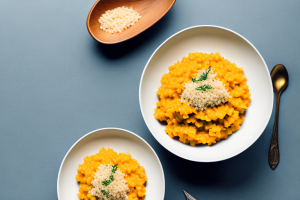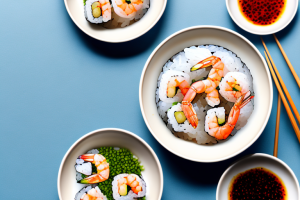How to stir-fry brown rice with bok choy and mushrooms
9 min read
A pan with stir-fried brown rice
Are you looking for a healthy and flavorful dish that’s easy to make? Look no further than stir-fried brown rice with bok choy and mushrooms. This dish is not only delicious, but also packed with nutrients that will leave you feeling satisfied and energized. In this article, we’ll take you step-by-step through the process of making this dish, covering everything from choosing the right ingredients to storing leftovers. Let’s get started!
Why stir-fry brown rice is a healthy and delicious option
Brown rice is a nutritious alternative to white rice, as it contains more fiber, protein, and minerals. Compared to white rice, brown rice takes longer to cook and has a nutty flavor. When stir-fried with bok choy and mushrooms, it becomes a delicious and healthy meal that’s perfect for lunch or dinner.
In addition to its nutritional benefits, brown rice is also a great option for those who are trying to manage their blood sugar levels. The fiber in brown rice slows down the absorption of glucose in the bloodstream, which can help prevent spikes in blood sugar levels.
Stir-frying brown rice with vegetables like bok choy and mushrooms not only adds flavor and texture, but also increases the nutrient content of the dish. Bok choy is a good source of vitamins A and C, while mushrooms are rich in antioxidants and B vitamins.
Choosing the right type of rice for your stir-fry
When choosing brown rice for your stir-fry, look for short-grain or medium-grain varieties. These types of rice are stickier and hold together well when stir-fried. Rinse the rice in cold water before cooking to remove any dust or debris. To cook rice, use a ratio of 1:2 (one cup of rice to two cups of water) and bring it to a boil. Then, reduce the heat and let it simmer for about 45 minutes or until all the water has been absorbed and the rice is tender.
Another important factor to consider when choosing rice for your stir-fry is the level of starchiness. If you prefer a drier and fluffier texture, go for long-grain rice. However, if you want a creamier and more cohesive texture, opt for short-grain or medium-grain rice. Additionally, you can add some flavor to your rice by cooking it in broth instead of water or by adding some spices or herbs to the cooking water.
Understanding the benefits of bok choy in your diet
Bok choy, also known as Chinese cabbage, is a leafy green vegetable that’s packed with vitamins and minerals. It’s low in calories and high in fiber, making it a great addition to any dish. Bok choy also contains antioxidants that may help protect against cancer and other diseases. When stir-fried, it provides a hearty crunch and adds a fresh flavor to the dish.
In addition to its nutritional benefits, bok choy is also a versatile vegetable that can be used in a variety of dishes. It can be eaten raw in salads, added to soups and stews, or used as a substitute for lettuce in sandwiches and wraps. Bok choy can also be pickled or fermented to create a tangy and flavorful side dish.
Furthermore, bok choy is easy to grow and can be cultivated in a variety of climates. It’s a great option for home gardeners who want to add fresh produce to their diet. Bok choy can be grown in containers or in the ground, and it’s a fast-growing crop that can be harvested in as little as 30 days.
The different types of mushrooms to use in your stir-fry
There are many types of mushrooms that work well in a stir-fry. Shiitake mushrooms are a popular option because of their meaty texture and rich flavor. Oyster mushrooms are also a good choice, as they have a delicate flavor and complement the other ingredients well. Button mushrooms and portobello mushrooms are more commonly found in grocery stores and can be used as a substitute if you can’t find the other varieties.
Another type of mushroom that can be used in stir-fry is Enoki mushrooms. These mushrooms have a mild flavor and a crunchy texture, which can add a unique element to your dish. They are also a good source of vitamins and minerals.
If you want to add a spicy kick to your stir-fry, you can use Thai bird’s eye chilies. These small, fiery chilies can be added to the stir-fry along with the mushrooms and other ingredients. They are commonly used in Thai cuisine and can add a burst of flavor to your dish.
Prepping and cutting your ingredients for the perfect stir-fry
Before you start cooking, it’s important to prep your ingredients. Wash and dry the bok choy and mushrooms, removing any dirt or debris. Cut the bok choy into bite-sized pieces, separating the white stems from the green leaves. Slice the mushrooms into thin strips. Cut any other vegetables, such as onions or garlic, and set aside.
Another important step in prepping your ingredients for a stir-fry is to marinate your protein. Whether you’re using chicken, beef, or tofu, marinating it for at least 30 minutes will add extra flavor to your dish. To make a simple marinade, mix together soy sauce, rice vinegar, honey, and minced garlic. Add your protein to the marinade and let it sit in the fridge while you prep your vegetables. This will ensure that your protein is tender and flavorful when added to the stir-fry.
Mastering the art of stir-frying: Tips and tricks for success
Stir-frying is a quick and easy cooking method that requires high heat and constant stirring. A good wok or skillet is essential for stir-frying. Heat your wok or skillet over high heat until it’s hot. Add a tablespoon of oil, such as canola or vegetable oil. Swirl the oil to coat the bottom of the wok or skillet. Add the vegetables and stir-fry for a few minutes until they are crisp-tender. Add the rice and stir-fry for another few minutes, using a spatula to break up any clumps of rice. Season with soy sauce or other seasonings, and stir-fry for another minute or two until everything is heated through.
One important tip for successful stir-frying is to prepare all of your ingredients ahead of time. This means chopping your vegetables, measuring out your rice and seasonings, and having everything within arm’s reach. Stir-frying is a fast-paced cooking method, so you don’t want to be scrambling to chop vegetables while your rice is burning in the wok.
Another trick for great stir-fry is to use high-quality ingredients. Fresh vegetables and high-quality rice will make a big difference in the final dish. Don’t be afraid to experiment with different vegetables and proteins, such as tofu or shrimp, to create new and exciting stir-fry dishes.
The importance of a good wok in stir-frying brown rice with bok choy and mushrooms
A good wok or skillet is essential for stir-frying. Woks are traditional Chinese cooking pans that are designed to distribute heat evenly and quickly. They have a round bottom and sloping sides, which allows you to toss and stir-fry the ingredients easily. Nonstick skillets are also a good alternative if you don’t have a wok.
When stir-frying brown rice with bok choy and mushrooms, it is important to use a wok or skillet that is large enough to accommodate all the ingredients. Overcrowding the pan can cause the ingredients to steam instead of stir-fry, resulting in a mushy texture. It is recommended to cook in batches if necessary.
Another important factor to consider when stir-frying is the order in which you add the ingredients. Start with the ingredients that take longer to cook, such as the brown rice, and gradually add the rest of the ingredients. This ensures that everything is cooked evenly and nothing is overcooked or undercooked.
How to season your stir-fry for maximum flavor
Seasoning is key to making a flavorful stir-fry. Soy sauce is a staple seasoning in Chinese cooking and works well in this dish. Other seasonings you can use include sesame oil, oyster sauce, hoisin sauce, and chili sauce. Start with a tablespoon of soy sauce and adjust to taste. You can also add garlic, ginger, or green onions for added flavor.
Another important factor in seasoning your stir-fry is the timing. It’s best to add the seasonings towards the end of the cooking process, so they don’t burn or evaporate. This will ensure that the flavors are well-incorporated into the dish and not overpowering.
Additionally, you can experiment with different herbs and spices to add more depth to your stir-fry. Some popular options include basil, cilantro, and lemongrass. Don’t be afraid to try new combinations and adjust the amounts to your liking. With a little bit of creativity and experimentation, you can create a stir-fry that is bursting with flavor.
Adding protein to your brown rice, bok choy, and mushroom stir-fry
If you want to add protein to your stir-fry, there are plenty of options. You can add tofu, chicken, beef, or shrimp. Simply cook the protein separately and add it to the stir-fry at the end. Tofu is a great option for vegetarians and vegans, as it provides a good source of protein.
Another great option for adding protein to your stir-fry is tempeh. Tempeh is a fermented soy product that has a nutty flavor and a firm texture. It’s a good source of protein, fiber, and various nutrients. To prepare tempeh for your stir-fry, slice it into small pieces and marinate it in your favorite sauce for at least 30 minutes before cooking.
If you’re looking for a non-meat option, you can also add beans or lentils to your stir-fry. These plant-based proteins are high in fiber and other nutrients, and they can add a hearty texture to your dish. Simply cook the beans or lentils separately and add them to the stir-fry at the end, or you can even use canned beans for a quick and easy option.
How to store leftovers from your stir-fry
If you have leftovers, store them in an airtight container in the refrigerator for up to three days. To reheat, microwave on high for 1-2 minutes or until heated through.
It’s important to note that you should let the stir-fry cool down to room temperature before storing it in the refrigerator. Putting hot food in the fridge can raise the temperature inside and potentially spoil other food items. Additionally, if you have a large amount of leftovers, consider dividing them into smaller portions before storing. This will make it easier to reheat only what you need and prevent unnecessary waste.
If you’re looking to get creative with your leftover stir-fry, try using it as a filling for wraps or sandwiches. You can also add it to a salad for a quick and easy lunch option. Just be sure to heat it up thoroughly before consuming.
Creative variations to try with brown rice, bok choy, and mushrooms in a stir fry
If you want to switch things up, try adding different vegetables or proteins to your stir-fry. Some popular options include bell peppers, carrots, snap peas, and broccoli. You can also experiment with different seasonings, such as curry powder or cumin.
Another way to add some variety to your stir-fry is to try using different types of rice. Brown rice is a great option for its nutty flavor and health benefits, but you could also try using white rice, jasmine rice, or even quinoa. Additionally, you can play around with the texture of your stir-fry by using different types of mushrooms, like shiitake or oyster mushrooms, or by adding in some crunchy water chestnuts or bamboo shoots.
Pairing dishes with your brown rice, bok choy, and mushroom stir-fry
This dish pairs well with other Asian-inspired dishes, such as spring rolls or dumplings. You can also serve it as a side dish with grilled chicken or fish. Enjoy!


